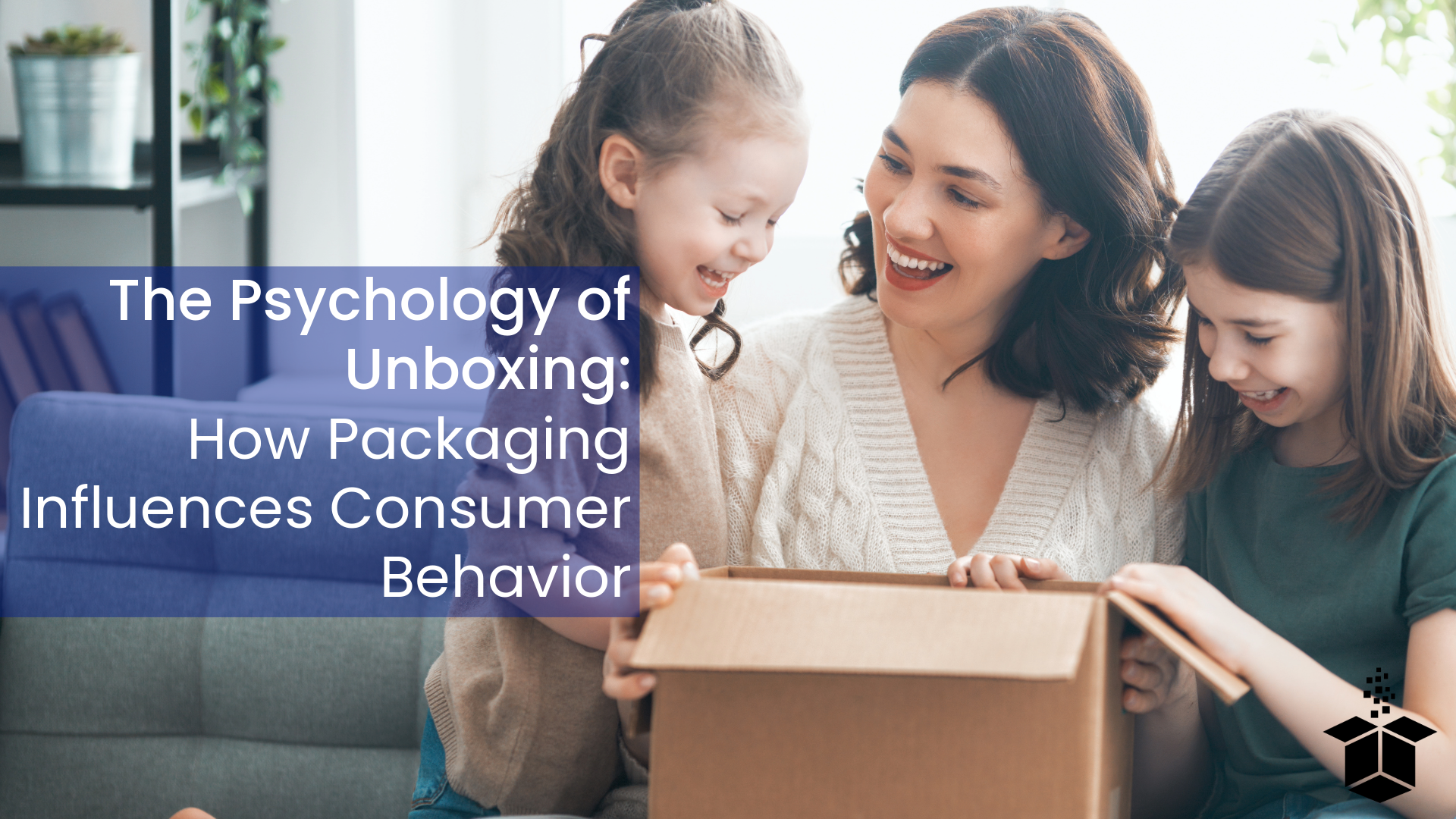The Psychology of Unboxing: How Packaging Influences Consumer Behavior
In the world of e-commerce, brick-and-mortar retail, and subscription services, packaging has evolved beyond a functional means of delivering products. It has become a key element of the consumer experience, offering brands the opportunity to connect emotionally with their customers. One area where this is especially apparent is the unboxing experience—the moment when a customer physically engages with a product for the first time. This critical juncture can significantly influence consumer behavior, leaving lasting impressions that drive brand loyalty, repeat purchases, and word-of-mouth recommendations.
In this post, we’ll explore the psychology behind unboxing, how it impacts consumer emotions and decision-making, and how custom packaging can be deliberately designed to evoke specific feelings that build stronger, long-lasting relationships with your customers.
The Rise of the Unboxing Phenomenon
Before looking into the psychology, it's important to understand how the unboxing experience became such a pivotal touchpoint in the customer journey. The rise of unboxing videos on social media platforms like YouTube, Instagram, and TikTok illustrates just how much attention is given to the act of opening a package. These videos, in which consumers or influencers meticulously unpack items while sharing their excitement, have garnered millions of views, making unboxing an online spectacle.
Unboxing taps into human curiosity, anticipation, and the joy of discovery. For consumers, the act of unwrapping a product provides a sense of ownership and involvement. In a sense, the package is the first physical representation of the brand a customer encounters, and this initial experience can shape their entire perception of the product and the company that provided it.
The Emotional Arc of Unboxing
The process of unboxing often mirrors an emotional arc. It begins with anticipation and curiosity, moves through excitement, and culminates in satisfaction or disappointment, depending on the quality of the experience. When done right, custom packaging can amplify these emotions, leading to a heightened sense of satisfaction that deepens the consumer’s connection with the brand.
1. Anticipation
The experience starts even before the consumer physically touches the package. It begins when they see the box at their doorstep or in the store. The design, texture, and overall presentation of the packaging can build up anticipation. If a package is sleek, unique, and thoughtfully designed, it suggests that the product inside is special. On the other hand, dull, generic packaging can flatten expectations before the consumer even engages with the product.
2. Excitement
As the unboxing continues, the consumer interacts with the packaging through touch, sound, and even smell. Opening a well-designed package can evoke feelings of excitement. The presence of custom features like branded tissue paper, ribbon ties, or a personalized thank-you note can surprise and delight, making the consumer feel valued. Each layer of packaging contributes to the overall sensory experience, making it memorable.
3. Satisfaction or Disappointment
Finally, the product is revealed. This is the emotional peak of the unboxing experience. If the packaging has built appropriate expectations, the product itself should match or exceed them. When the entire experience feels cohesive—from outer packaging to product presentation—consumers are more likely to feel satisfied. However, if there is a mismatch between packaging and product quality, the customer may feel underwhelmed or even deceived, resulting in a negative brand impression.
How Packaging Influences Consumer Decision-Making
Packaging is more than just an aesthetic choice; it can influence consumer decision-making in subtle but profound ways. By understanding how various elements of packaging impact psychology, brands can craft custom packaging that drives purchasing behavior.
1. Perceived Value
A well-designed, premium-looking package signals to consumers that the product inside is of high value. This perception often influences their willingness to pay more. Studies have shown that consumers are willing to spend more on products that come in high-quality packaging because it creates an assumption of superior product quality. In this way, packaging design becomes an extension of the product itself, shaping how much value consumers place on the item.
For example, think of luxury brands like Apple or Chanel. Their minimalistic, high-end packaging design sets the tone for the entire experience, suggesting that the product inside is a reflection of quality, innovation, and style. This psychological association between packaging and value can drive consumers to make purchasing decisions based on the packaging alone.
2. Emotional Connection
Custom packaging can also tap into emotions, which are a powerful driver of consumer behavior. Packaging designed to evoke specific feelings—whether it's excitement, nostalgia, or a sense of luxury—can create emotional bonds between the consumer and the brand. Brands that evoke positive emotions during the unboxing experience are more likely to see repeat purchases and foster customer loyalty.
Emotional packaging can also serve as a tool for storytelling. By incorporating elements that resonate with the brand’s story or values, companies can create deeper connections with their customers. For example, eco-conscious brands may use sustainable materials or minimalist designs to align with their environmental values, reinforcing their brand identity and connecting with like-minded consumers.
3. First Impressions and Brand Perception
First impressions matter, and packaging is often the first physical interaction a consumer has with a brand. Research indicates that consumers form judgments about a product’s quality within seconds of seeing its packaging. A well-crafted package can make a product feel more trustworthy, exciting, or professional, influencing how likely a consumer is to try the product or recommend it to others.
Consistency is also key. Brands that maintain consistent packaging designs across product lines and over time create a strong brand identity. This consistency helps consumers quickly recognize the brand, enhancing trust and loyalty.
4. Social Influence
As mentioned earlier, unboxing has become a social phenomenon, with consumers sharing their experiences on social media. This trend offers an opportunity for brands to extend the reach of their marketing efforts through user-generated content. Custom packaging that is eye-catching, unique, or interactive is more likely to be shared online, providing free advertising and generating buzz around the brand.
In this context, packaging serves as a form of social proof. When consumers see others sharing positive unboxing experiences, it influences their perception of the brand and can lead to increased sales. In this way, packaging not only impacts the individual consumer but also has a ripple effect on their social circles.
Designing Custom Packaging to Evoke Specific Feelings
Now that we understand how unboxing influences consumer behavior, let’s explore how custom packaging can be deliberately designed to evoke specific emotions and drive brand loyalty. The right combination of visual, tactile, and functional elements can create an experience that resonates with your customers.
1. Visual Appeal
Visual design is one of the most powerful tools for shaping consumer emotions. The choice of colors, fonts, and imagery can all contribute to how a consumer feels when they first see the package.
- Colors: Different colors evoke different emotional responses. For example, red can create a sense of urgency or excitement, while blue can be calming and convey trustworthiness. Brands should choose colors that align with their identity and the emotions they want to elicit.
- Typography: The choice of fonts can also influence perception. Elegant, serif fonts suggest luxury, while bold, sans-serif fonts can communicate modernity or innovation.
- Imagery and Graphics: Custom illustrations or branded patterns can create a sense of playfulness, elegance, or sophistication, depending on the style.
2. Tactile Experience
The feel of the packaging is just as important as its visual design. Touch is a critical part of the unboxing process, and different materials can evoke different emotions.
- Materials: The choice of materials can signal quality and reinforce brand values. For example, a brand focused on sustainability might use recycled paper or biodegradable materials. A luxury brand might use textured paper, soft-touch finishes, or metallic accents to create a premium feel.
- Textures: Incorporating textures into packaging, like embossing, debossing, or foil stamping, can create a more engaging tactile experience. These elements not only make the packaging more interesting to touch but also add to the perceived value of the product.
3. Functional Design
A well-designed package isn’t just beautiful; it’s also functional. Thoughtful design that makes unboxing easy and enjoyable can enhance the overall experience.
- Ease of Opening: No one enjoys struggling with difficult packaging. Easy-to-open designs, like magnetic closures or pull tabs, can make the unboxing process smoother and more enjoyable.
- Multi-Layered Experience: Introducing layers within the packaging—such as a box within a box, or additional inserts like tissue paper or a branded sleeve—can prolong the sense of discovery and excitement. Each layer offers an opportunity to engage the customer further.
- Personalization: Adding a personal touch, like a thank-you card with the customer’s name or a handwritten note, can make the unboxing feel special and intimate. This small gesture can go a long way in fostering a sense of connection between the consumer and the brand.
The Long-Term Impact of Unboxing on Brand Loyalty
The unboxing experience is more than a fleeting moment; it has a lasting impact on brand loyalty and customer retention. When consumers have a positive unboxing experience, they’re more likely to associate those positive emotions with the brand, making them more inclined to purchase from the company again. This emotional connection can be even stronger than price or convenience, making packaging an essential element in building long-term customer relationships.
Moreover, a memorable unboxing experience encourages word-of-mouth marketing. Customers who are impressed with the packaging are more likely to share their experience with friends, family, or even their social media followers, amplifying the brand’s reach and reputation.
Conclusion
The psychology of unboxing reveals that packaging is much more than just a vessel for delivering products—it’s a powerful tool for influencing consumer behavior, shaping brand perceptions, and driving customer loyalty. By understanding the emotional arc of unboxing and how different elements of packaging—such as visual appeal, tactile experience, and functional design—affect consumer psychology, brands can create meaningful, lasting impressions.
When custom packaging is thoughtfully designed to evoke specific emotions—whether it’s excitement, surprise, or a sense of luxury—it enhances the consumer’s experience in a way that goes beyond the product itself. The unboxing moment becomes a key brand touchpoint, reinforcing positive associations and building emotional connections with the customer. This, in turn, translates into stronger brand loyalty, repeat purchases, and organic word-of-mouth marketing.





